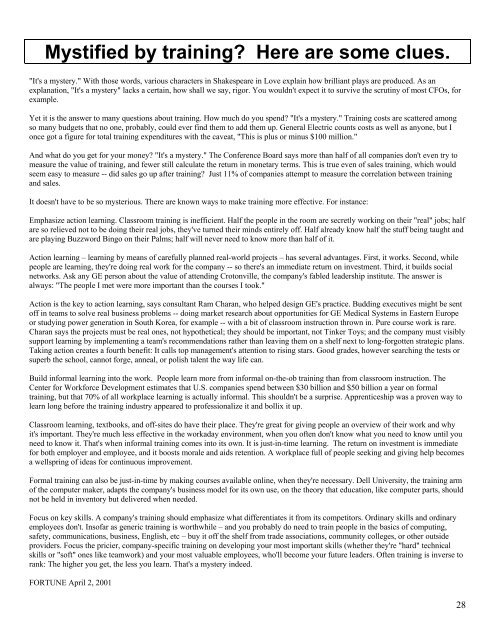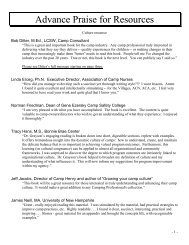Taking Camp Staff Training From Good To Best ... - Vision Realization
Taking Camp Staff Training From Good To Best ... - Vision Realization
Taking Camp Staff Training From Good To Best ... - Vision Realization
You also want an ePaper? Increase the reach of your titles
YUMPU automatically turns print PDFs into web optimized ePapers that Google loves.
Mystified by training? Here are some clues.<br />
"It's a mystery." With those words, various characters in Shakespeare in Love explain how brilliant plays are produced. As an<br />
explanation, "It's a mystery" lacks a certain, how shall we say, rigor. You wouldn't expect it to survive the scrutiny of most CFOs, for<br />
example.<br />
Yet it is the answer to many questions about training. How much do you spend? "It's a mystery." <strong>Training</strong> costs are scattered among<br />
so many budgets that no one, probably, could ever find them to add them up. General Electric counts costs as well as anyone, but I<br />
once got a figure for total training expenditures with the caveat, "This is plus or minus $100 million."<br />
And what do you get for your money? "It's a mystery." The Conference Board says more than half of all companies don't even try to<br />
measure the value of training, and fewer still calculate the return in monetary terms. This is true even of sales training, which would<br />
seem easy to measure -- did sales go up after training? Just 11% of companies attempt to measure the correlation between training<br />
and sales.<br />
It doesn't have to be so mysterious. There are known ways to make training more effective. For instance:<br />
Emphasize action learning. Classroom training is inefficient. Half the people in the room are secretly working on their "real" jobs; half<br />
are so relieved not to be doing their real jobs, they've turned their minds entirely off. Half already know half the stuff being taught and<br />
are playing Buzzword Bingo on their Palms; half will never need to know more than half of it.<br />
Action learning – learning by means of carefully planned real-world projects – has several advantages. First, it works. Second, while<br />
people are learning, they're doing real work for the company -- so there's an immediate return on investment. Third, it builds social<br />
networks. Ask any GE person about the value of attending Crotonville, the company's fabled leadership institute. The answer is<br />
always: "The people I met were more important than the courses I took."<br />
Action is the key to action learning, says consultant Ram Charan, who helped design GE's practice. Budding executives might be sent<br />
off in teams to solve real business problems -- doing market research about opportunities for GE Medical Systems in Eastern Europe<br />
or studying power generation in South Korea, for example -- with a bit of classroom instruction thrown in. Pure course work is rare.<br />
Charan says the projects must be real ones, not hypothetical; they should be important, not Tinker <strong>To</strong>ys; and the company must visibly<br />
support learning by implementing a team's recommendations rather than leaving them on a shelf next to long-forgotten strategic plans.<br />
<strong>Taking</strong> action creates a fourth benefit: It calls top management's attention to rising stars. <strong>Good</strong> grades, however searching the tests or<br />
superb the school, cannot forge, anneal, or polish talent the way life can.<br />
Build informal learning into the work. People learn more from informal on-the-ob training than from classroom instruction. The<br />
Center for Workforce Development estimates that U.S. companies spend between $30 billion and $50 billion a year on formal<br />
training, but that 70% of all workplace learning is actually informal. This shouldn't be a surprise. Apprenticeship was a proven way to<br />
learn long before the training industry appeared to professionalize it and bollix it up.<br />
Classroom learning, textbooks, and off-sites do have their place. They're great for giving people an overview of their work and why<br />
it's important. They're much less effective in the workaday environment, when you often don't know what you need to know until you<br />
need to know it. That's when informal training comes into its own. It is just-in-time learning. The return on investment is immediate<br />
for both employer and employee, and it boosts morale and aids retention. A workplace full of people seeking and giving help becomes<br />
a wellspring of ideas for continuous improvement.<br />
Formal training can also be just-in-time by making courses available online, when they're necessary. Dell University, the training arm<br />
of the computer maker, adapts the company's business model for its own use, on the theory that education, like computer parts, should<br />
not be held in inventory but delivered when needed.<br />
Focus on key skills. A company's training should emphasize what differentiates it from its competitors. Ordinary skills and ordinary<br />
employees don't. Insofar as generic training is worthwhile – and you probably do need to train people in the basics of computing,<br />
safety, communications, business, English, etc – buy it off the shelf from trade associations, community colleges, or other outside<br />
providers. Focus the pricier, company-specific training on developing your most important skills (whether they're "hard" technical<br />
skills or "soft" ones like teamwork) and your most valuable employees, who'll become your future leaders. Often training is inverse to<br />
rank: The higher you get, the less you learn. That's a mystery indeed.<br />
FORTUNE April 2, 2001<br />
© Randall Grayson, Ph.D. www.visionrealization.com ver. 2.2 28





